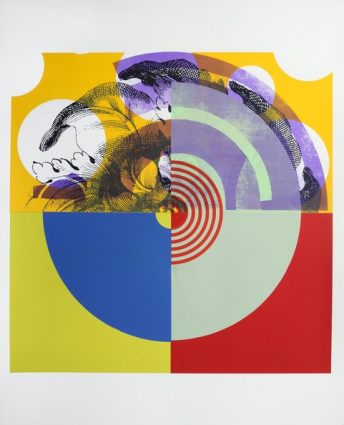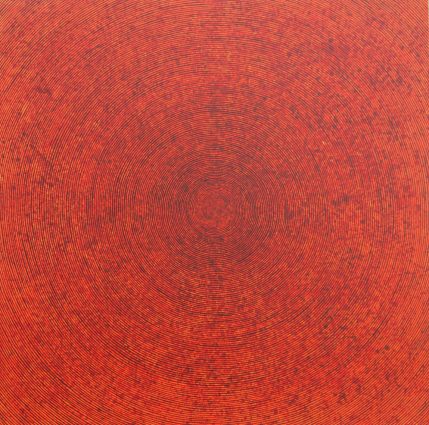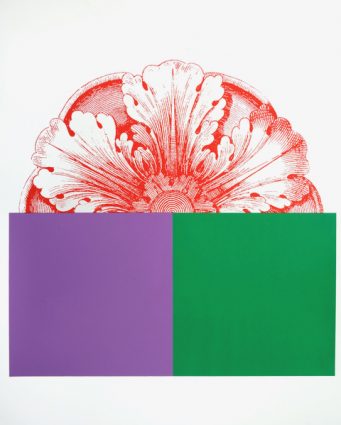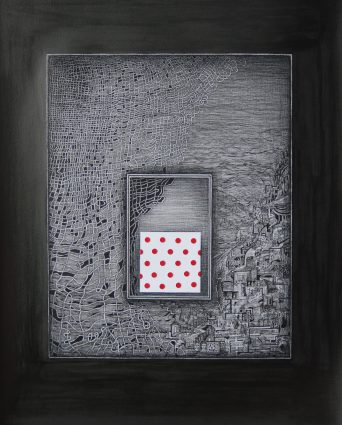“Immemorial” can mean many things, especially to artists. And so it was that Amina K. Cooper of the Arts and Humanities Council of Montgomery County (AHCMC) decided that a project that celebrates the eternal nature of art would be a fine way to close out the 2018 artistic calendar at the Kramer Gallery in Silver Spring.
The exhibit, “Immemorial,” on view through Dec. 7, features the works of local artists Susan Goldman and Shanthi Chandrasekar, a printmaker and painter, respectively. The two women had not worked together before.

“[Cooper] asked if I would be comfortable being exhibited with Shanthi, whose work I didn’t know quite well, but I’d met her and quite liked her,” Goldman said. “Her concept was that both Shanthi and I were dealing with ‘the circle’ in our work [as a symbol of] time.”
Goldman’s eight works in “Immemorial” include screenprints and monotypes wherein the circle motif unites “prints from different bodies of work included in the exhibition.” Chandrasekar’s contributions include her “Red Dot” series of ink drawings and paintings that make use of the circle as a locus of spiritual power.
“In a lot of my work, time is represented by lines,” Chandrasekar said, noting that her contributions also will include works from her “Chakra” series. “The line represents the flow of time through space. The spiral [represents that] we don’t know what’s going to come.
“I’m always thinking in terms of what we see now is just one small period of time,” she added. “And that could be short, like two minutes, or it could be two years or two centuries. So the spiral, the chakras, [represent] that.”

Both artists said that while they had no specific input into Cooper’s “Immemorial” concept, they worked with the curator to ensure that the works being displayed for the exhibition closely matched the theme that Cooper was going for.
“My work came out of working with the flower, specifically the blossom, and then I integrated my flower idea thematically with the idea of geometric spiraling, kind of interacting,” Goldman said, pointing out that she was partly inspired by Leonardo da Vinci’s notions of “squaring the circle.”
“The ‘Red Dot’ series was a search for something in the same way the ‘Chakra’ series was a search for something,” said Chandrasekar of her contributions. “I’m trying to understand that, but I can’t. It’s beyond our perception, wherever the dreams are.”

A great deal of how Chandrasekar focuses on the theme of time and eternity in her art, she said, springs from a dream she had as a young woman, in which she felt the power of presence from a door in her grandmother’s home in India. “In southern India, we have turmeric powder and red dots on the bottoms of doorways,” she said. “So, words that came in my dream [represented] all the possibilities” for her “Red Dot” series.
“I think that is a memory that was lost, and it became something that came through,” Chandrasekar said of the metaphorical door. “My first painting in that series, I actually had painted the doorway, but at that point, I did not know I had stared at those red dots. So, I think ‘Immemorial’ fits in that way.”
Goldman’s mission is to create beauty in art as well as to give her audience something to contemplate — both while they behold the artworks and long after they’ve left the gallery. “The circle represents the self, it represents the center, it represents the whole,” she said of the motif behind “Immemorial.” “It’s such an important, iconic symbol that runs through all cultures.”

“The ‘Red Dot’ series is something one of my [friends] said the pictures don’t do justice,” Chandrasekar said, encouraging the public to see her works in person. “When you get closer, you see there’s a lot more happening there. … Those details are actually a visual journal of my dreams. You stand in front of it, and you start seeing a whole lot of magic appear.”
Since art has the power to both heal and inspire, Goldman said that coming to “Immemorial” will allow audiences to take a break from the ongoing stressful news cycle and offer an alternative to staring at a computer screen all day long.
“I want people to be moved emotionally or to make them feel better,” she said. “We live in stressful times, and art can be a [way] to contemplate [other] things. I’m not trying to be religious, but you’re going into a space that takes your mind off your busy brain.”
“Immemorial” is on view at the Kramer Gallery, 1 Veterans Place, Silver Spring, through Dec. 7. The gallery is open weekdays, 10 a.m. to 6 p.m. Admission is free and open to the public. Call 301-565-3805 or visit www.bettymaekramergallery.com/current-exhibition-immemorial.